eero Outdoor 7: Specs
eero Outdoor 7 review: Specs
Wi-Fi specification: BE2100 (802.11be)
Number of antennas/removable: 5/No
Ports: 2.5 Gbps
Processor/memory/storage: 1.5 GHz quad-core/1GB/4GB
Wi-Fi chip: Qualcomm IPQ5332
Peak 802.11ax performance: 879.7 Mbps (at 15 feet)
Maximum range: 95 feet
Size: 8.2 x 6.3 x 3.2 inches
Estimated annual electricity cost: $5.95 (wireless), $35.00 (POE+ wired)
The age of the indoor-only Wi-Fi may be at an end thanks to the eero Outdoor 7 which has the ability to wire (or unwire) the great outdoors with a dual-band mesh node that can dole out Wi-Fi 7 data while standing up to Mother Nature. The satellite easily links with an eero network to provide all the goodies of a Wi-Fi 7 network, except using the high-performance 6 GHz transmission band.
Easy to set up and reliable, the Outdoor 7 node combines Wi-Fi 7 speeds and IP66 weatherproofing but using its Power over Ethernet (POE) abilities for a single cable install requires extra gear and the eero Plus package which also includes extra security, parental control software and networking stats for $100 per year. It may be the ticket for alfresco Internet but will it fit in your home, yard and budget. My eero Outdoor 7 review will help you decide if this is the perfect accessory for one of the best mesh Wi-Fi systems from eero.
eero Outdoor 7 review: Pricing and availability
Amazon has updated its powerful eero Max 7 mesh networking kit with the Outdoor 7, a weatherized node for exterior use. A unique product, the Outdoor 7 is rated to cover up to 15,000 square feet and costs $400 with an AC adapter. Eero also sells a $350 standalone Outdoor 7 for use with a POE+ network and a $400 10-port POE+ switch with 2.5 Gbps and 10 Gbps ports.
eero Outdoor 7 review: Design
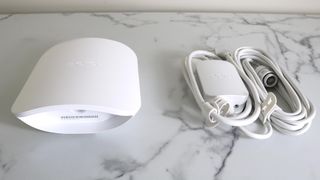
With a similar design to a traditional eero mesh unit with the back cut off, the Outdoor 7 slides into the included mounting bracket. When installed, it looks like a small shield that at 8.2 x 6.3 x 3.2 inches can go unnoticed on a wall were it not for the fact that it’s only available in white. In other words, it can stand out like a sore thumb against a dark wall.
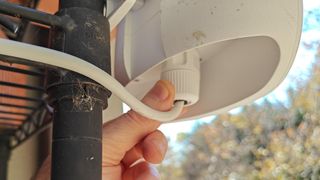
With an IP66 dust and water intrusion rating, the Outdoor 7 includes a silicone cable cap and a Gore-Tex-like expanded polytetrafluoroethylene (ePTFE) polymer seal that blocks water entry but allows condensation and warm air to escape. It can stand up to the elements though, including a 100 mph gale resistance and a temperature range of -40 to 131 degrees Fahrenheit – good from Fairbanks to Death Valley. Overall, the Outdoor 7 performed well in the milder suburbs north of New York City, working through several downpours and subzero nights.
Built around Power Over Ethernet (POE), the unit’s 2.5 Gbps Ethernet port is also how it’s powered. In fact, the included AC adapter is a POE+ injector that only carries power. The beauty of this design is that it allows power and data to flow over a single cable but you’ll need a POE+ data and power injector for that as well as a home that’s wired for Ethernet.
It lacks an on/off switch but there’s a reset button and a grounding connection for those with lightning problems. Based on Qualcomm’s IPQ5332 chipset, a 1.5 GHz quad-core processor, 1GB of RAM and a generous 4GB of flash storage space, it’s able to route data to and from up to 200 clients and works with older eero gear like the eero Pro 6E or the eero 6+.
The dual-band Outdoor 7 uses 2X2 data streaming over the 2.4 and 5 GHz bands but lacks the all-out performance of the 6 GHz band. Its five antennas create a spherical transmission pattern that uses 4K Quadrature Amplitude Modulation (QAM) to send data over 320 MHz channels; the nodes use a 240 MHz backhaul channel and can be wired. It’s rated at a peak throughput of BE2100, one-tenth the Max 7’s 20.8 Gbps output.
Each Outdoor 7 node can connect to the router or another node, allowing effective outdoor mesh networking for connecting a workshop, satellite office or large backyard. It’s also a master of home automation with Thread, Zigbee, and Matter protocols built-in for controlling the best smart lights or viewing live feeds from the best outdoor security cameras.
On the other hand, the Outdoor 7 ignores the Wi-Fi Protected Setup (WPS) that speeds adding devices because it’s – according to eero – too insecure. While many competitors include an extra security layer with their networking products, eero Plus goes further with a package that includes Malwarebytes Premium Security, Guardian’s VPN and 1Password. It costs $100 a year.
eero Outdoor 7 review: Performance
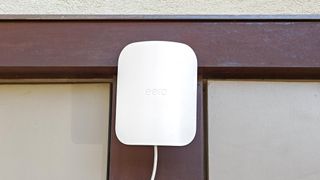
I added the Outdoor 7 to a Max 7 network using its wireless abilities. While the data signal had to travel across a 20-foot room and through the house’s stucco exterior to the Outdoor 7, it filled a 20,000 square foot outdoor area with data.
Using Keysight’s IxChariot networking benchmark to simulate 10 active users with a Wi-Fi 7 equipped Acer Swift Edge 16 notebook, the Outdoor 7 topped out with 987.2 Mbps of throughput close up. This dropped to 879.7 Mbps at the more realistic distance of 15-feet – about half the indoor-only Max 7’s 1.781 Gbps. The performance gap can be explained by the 6 GHz band’s absence.
Swipe to scroll horizontally
| Row 0 - Cell 0 | Eero Outdoor 7 (wireless) | Eero Outdoor 7 (wired) | Eero Max 7 |
| 15 feet | 879.7 Mbps | 762.4 Mbps | 1.781 Gbps |
| 50 feet | 388.5 Mbps | 473.5 Mbps | 146.9 Mbps |
| 75 feet | 274.9 Mbps | 232.0 Mbps | 132.7 Mbps |
| 90 feet | 52.2 Mbps | 39.8 Mbps | 16.8 Mbps |
At 50 feet, the Outdoor 7’s wireless throughput of 388.5 Mbps was more than double the Max 7’s bandwidth, a ratio that held true at 75 feet with the Outdoor 7’s 274.9 Mbps versus 132.7 Mbps for the Max 7. Its 90-foot result of 52.2 Mbps was more than three-times the 16.8 Mbps that the Max 7 yielded.
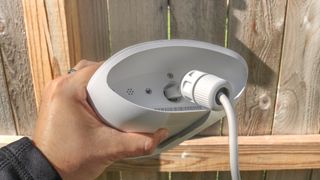
Next, I used eero’s POE+ network switch and wired data. The hardest part was getting the cable cap off the included power cable and installing it on the data cable; including an extra would have helped. That said, it balked with an older TP-Link POE injector but worked with Trendnet’s $25 TPE-215GI POE+ injector.
At 762.4 Mbps, the throughput at 15 feet was slightly off its wireless performance but the Outdoor 7 caught up with 473.5 Mbps available at 50 feet, a third more throughput than the wireless connection’s 388.5 Mbps. At 75- and 90-feet, the device hit 232.0 Mbps and 39.8 Mbps.
It didn’t matter if the Outdoor 7 was in wireless or wired mode, it had the same 95-foot range. With a second Outdoor 7 node 35 feet away, I bathed my backyard in high-speed Internet.
The Outdoor 7 aced my saturation test where I used several computers for different purposes: a Samsung Galaxy Book played the BBC news feed, an HP Dragonfly notebook cycled through a Spotify play list and an iPad Pro played YouTube videos while a Samsung Galaxy Book swapped data with a networked RAID storage array. All the audio and video came through without a problem, freeze or lost frame.

Using the AC adapter, the Outdoor 7 required 6.3 watts of power that dropped to 2.2 watts at idle by using the Eco Efficiency mode, although it can take a few seconds to wake up. By contrast, the eero POE+ switch used 25 watts, including powering the Outdoor 7. Assuming you pay the national average of 16 cents per kilowatt hour for electricity, the Outdoor 7 should cost $5.95 annually in wireless mode and $35 a year with the POE+ switch.
eero Outdoor 7 review: Setup
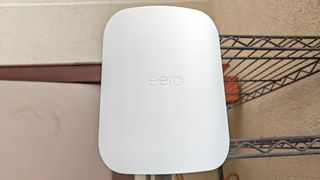
Due to its outdoorsy attitude, the Outdoor 7 is a little trickier to set up than just putting a mesh node on an end table. The kit included screws, plastic anchors and clips for attaching to vinyl siding but I set it up on a pole by snaking a flexible hose clamp through the mounting bracket.
I plugged the power adapter into the Outdoor 7’s Ethernet port and screwed its seal tight. I slid it into the bracket.

Using the eero app, I tapped “+” in the upper right, followed by checking that it’s an Outdoor 7 model. There are apps for Android and iPhone but no connected browser installation routine.

The app quickly found the Outdoor 7 and I named it “Driveway”. My last step was to add another Outdoor 7 node 35 feet from the “Driveway” unit named “Back yard”. All told, it took 13 minutes, including the physical installation. At this point, I was able to stay online on my driveway, patio and yard.
Eero Outdoor 7 review: Configuration

The eero app’s Home screen shows the essentials, like Internet access as well as online and disconnected nodes.
Scroll down to see recently connected devices, extra security or business services. At the bottom are tabs for Devices, Activity and Settings.
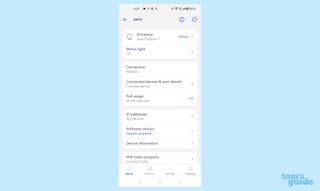
Tap on the Outdoor 7’s line to reveal the type of connection (wireless or wired) and its IP address. It’s where I updated its firmware.
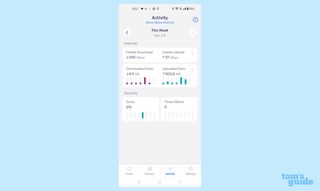
While the Devices tab shows the connected clients, Settings has the week’s data flow into and out of the network in excellent bar graphs.
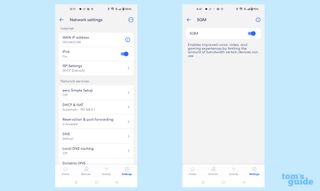
There’s also useful info about the account, the network’s name, password and the Guest Network. I could setup DHCP auto IP addressing and use Thread compatible home automation devices
The eero’s Smart Queue Management (SQM) selection optimizes the data flow and shapes the traffic to prioritize the most time-sensitive packets to improve video calls and gaming.
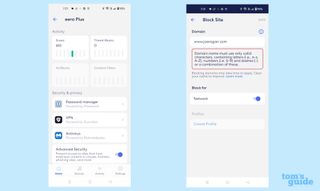
Adding the eero Plus plan helps with useful LAN stats and parental control software. The big addition though is extra security to block individual sites, malware and ads. It costs $100 a year and includes Malwarebytes Premium Security, Guardian’s VPN and 1Password.

Happily, the Outdoor 7 has a three-year warranty – three times longer than the company’s indoor Wi-Fi products. There’s no shortage of online help with the app’s support link, including installation videos for common construction materials.

In addition to the Health Check’s LAN reliability analysis, the app includes links to the product’s help pages as well as the support phone number and email address, something that I wish all router makers would do.
eero Outdoor 7 review: Verdict
Got a disconnected porch, driveway or garage that you’ve wanted to include on your mesh network? The Outdoor 7 is not only weatherproof but complements eero networking gear of all vintages. It has everything that Wi-Fi 7 brings except 6 GHz transmissions but when you’re streaming episodes of “Dark Winds” on your patio, you’ll hardly notice the difference.
Able to connect wirelessly or via a single Ethernet cable with POE+, the Outdoor 7 is versatile and easy to configure. The dual-band device may not be the fastest, but it’s a good way to fill a yard with Wi-Fi while the $100 a year eero Plus package adds malware protection, parental controls and networking stats.
Unique in the expanding world of Wi-Fi 7 mesh systems, the Outdoor 7 may not be a bargain at $400 but the eero Outdoor 7 node is the best way to connect in the great outdoors.




















 English (US) ·
English (US) ·